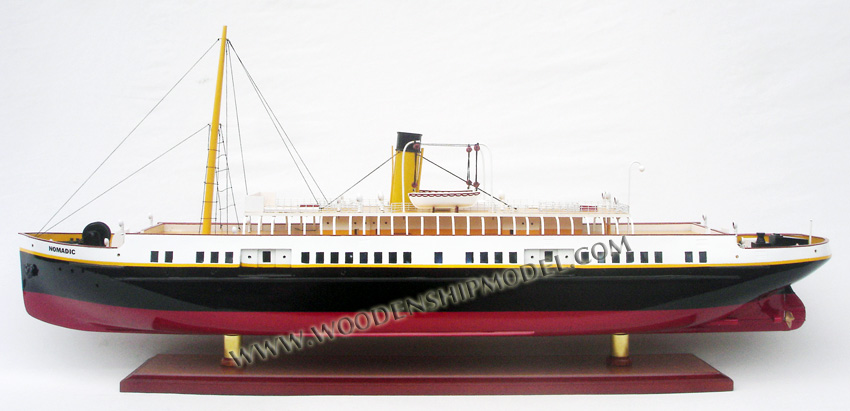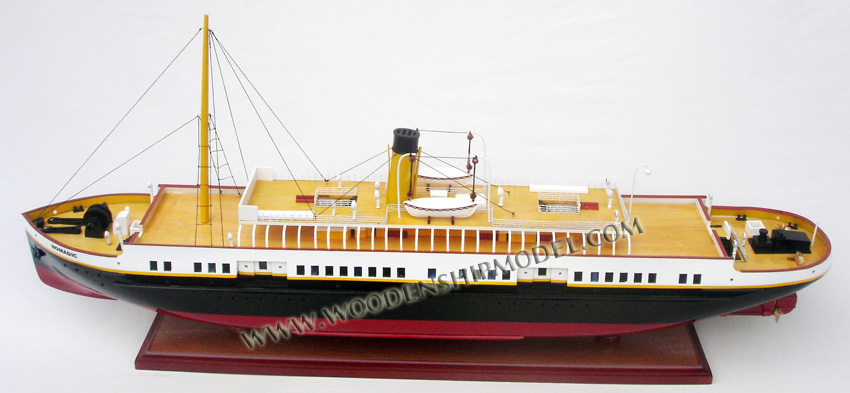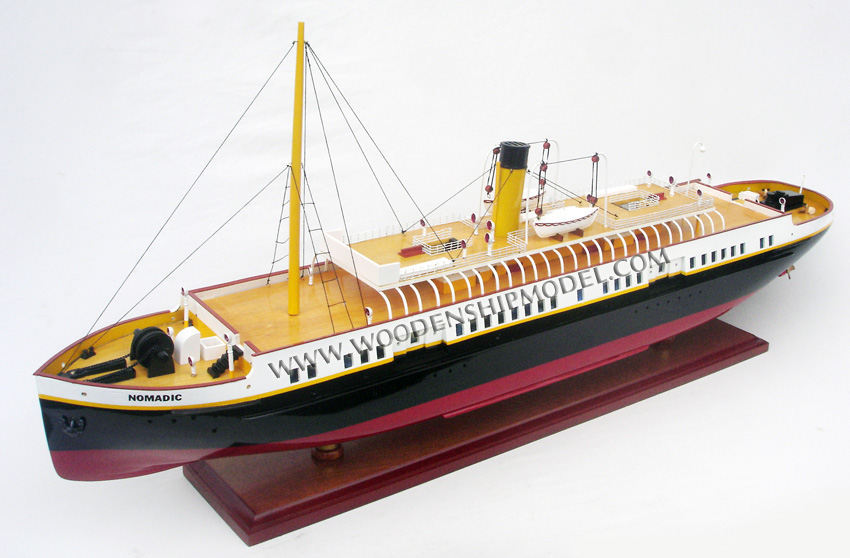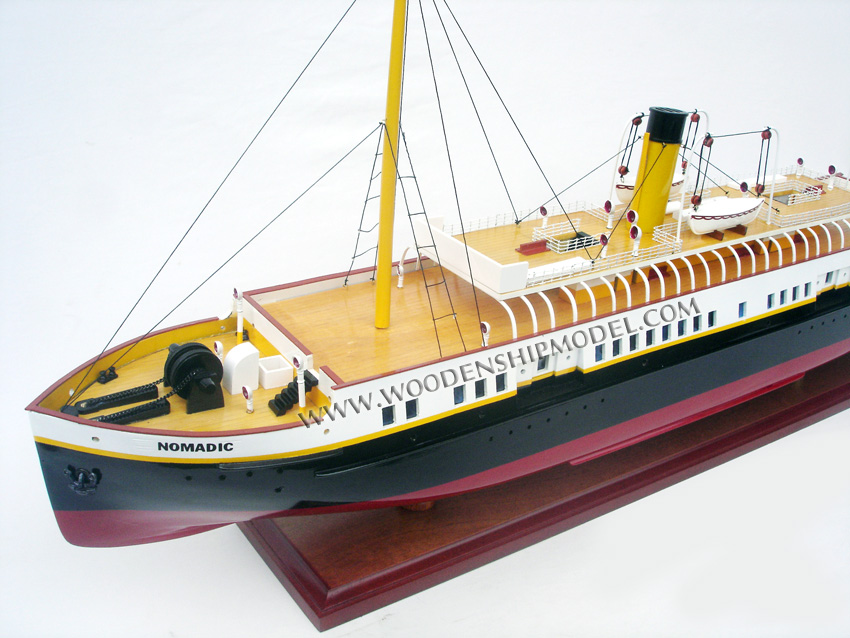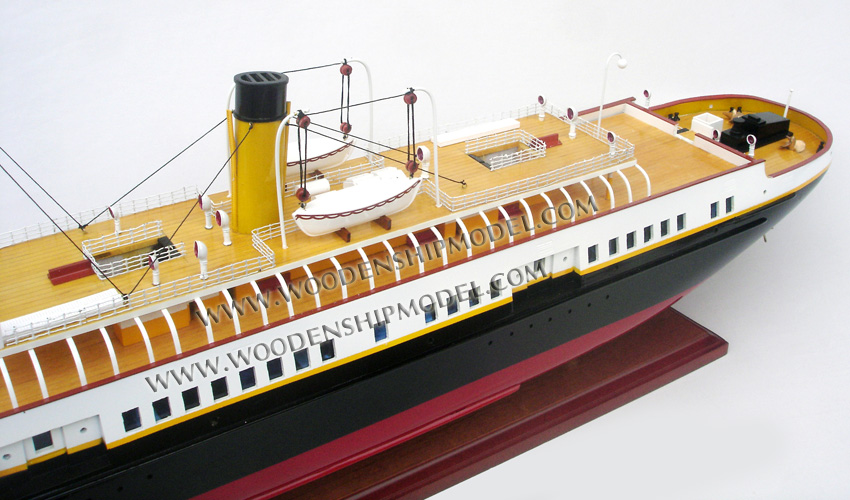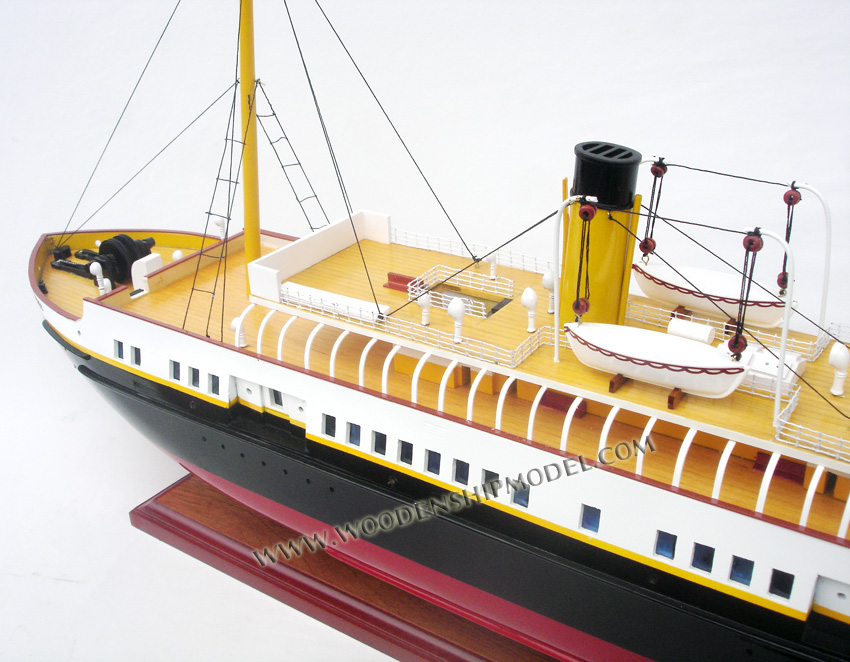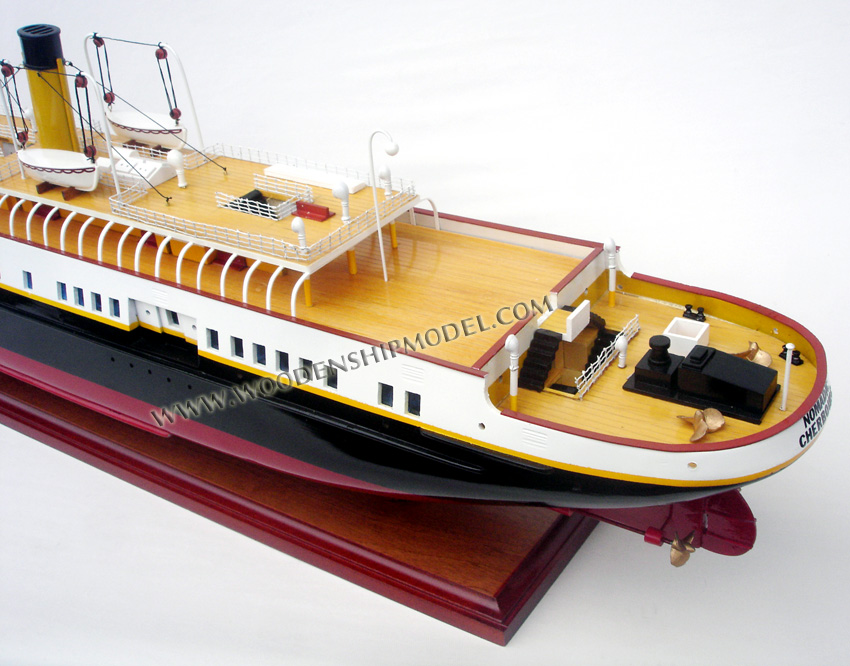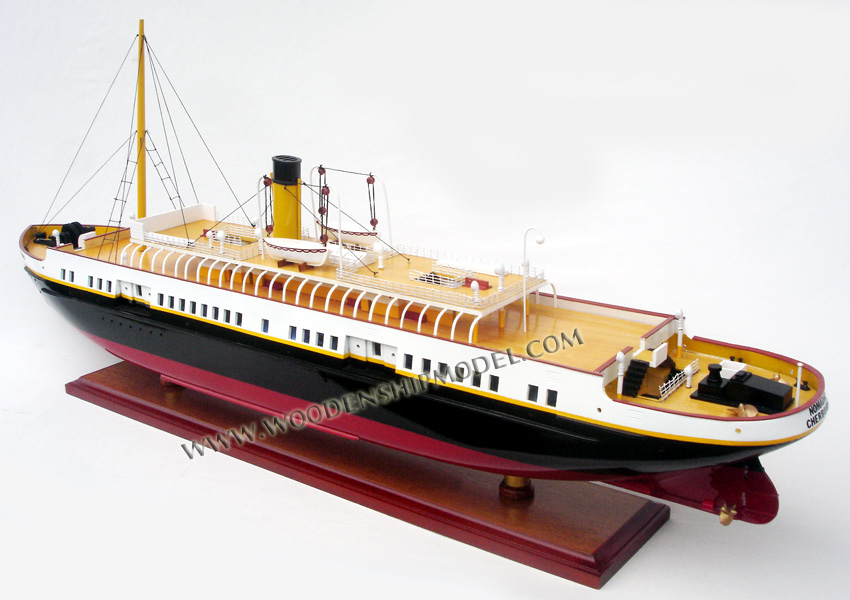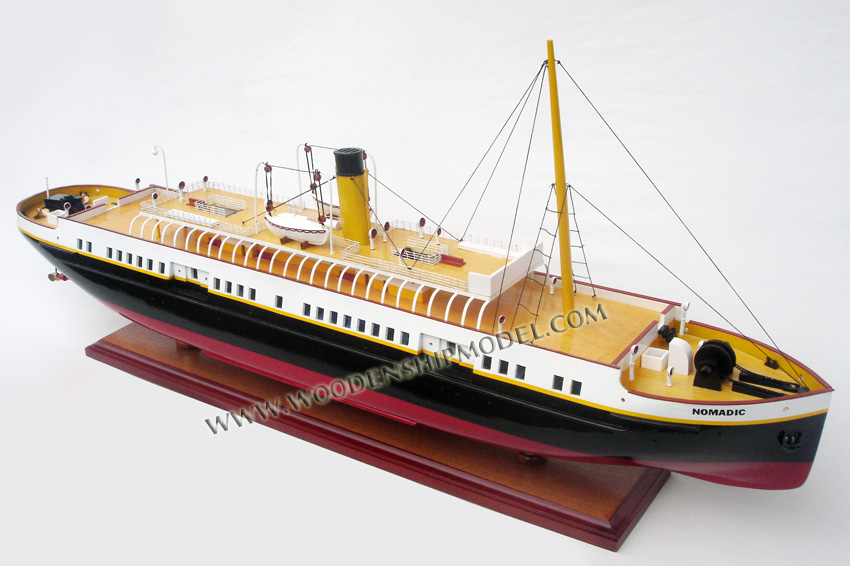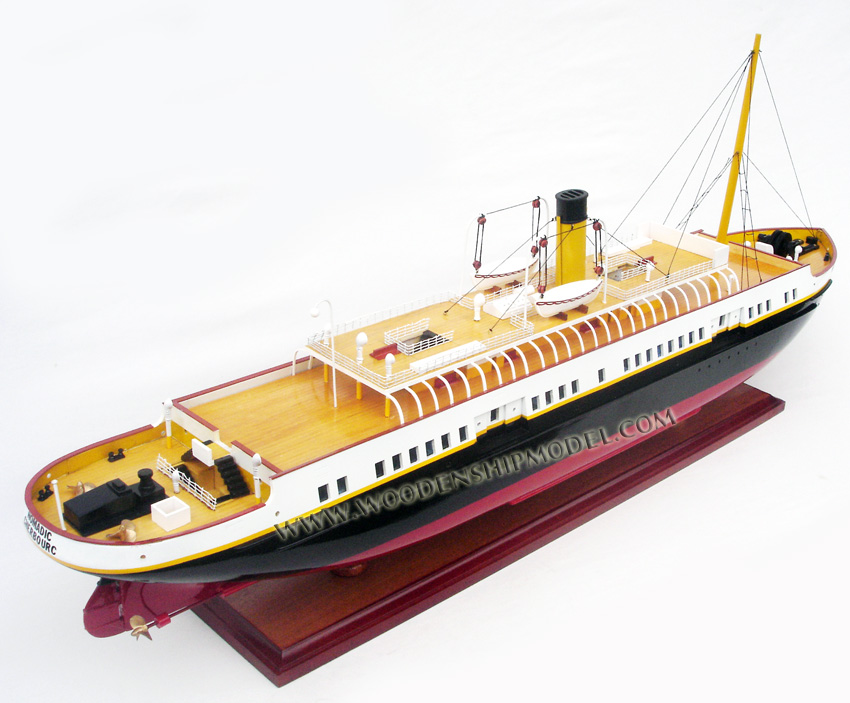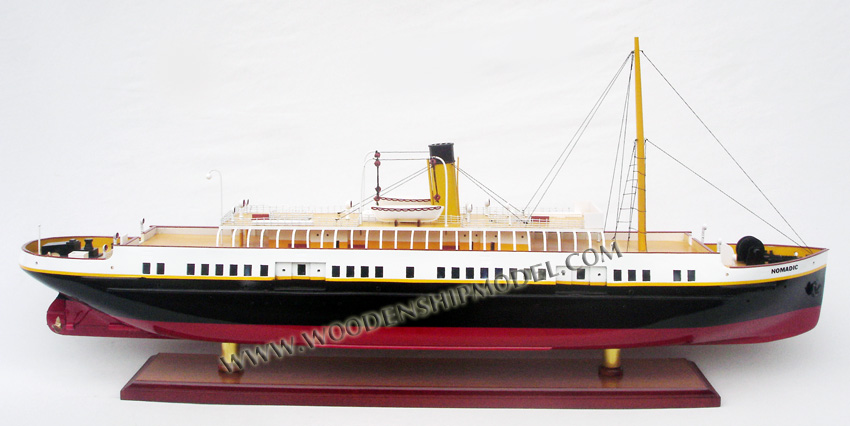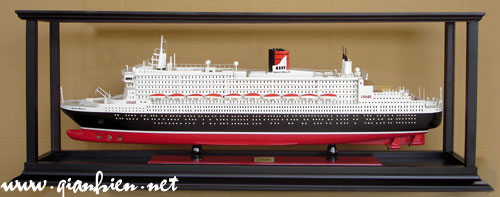|
History of SS Nomadic (1911)
SS Nomadic is a steamship of the White Star Line, launched
on 25 April 1911 in Belfast. She was built as a tender to
RMS Olympic and RMS Titanic.
Background
Nomadic was commissioned by the White Star Line in 1910, to
tender for their new ocean liners RMS Olympic and RMS
Titanic, which were too large to dock in Cherbourg harbour.
She and her running mate SS Traffic ferried passengers,
their baggage, mail and ship's supplies to and from large
ocean liners moored off-shore.
The keel of Nomadic was laid down in the Harland and Wolff
shipyards, Belfast in 1910 (yard number 422). She was built
on slipway No. 1 alongside RMS Olympic and RMS Titanic,
which were constructed on slipways 2 and 3 respectively. She
was launched on 25 April 1911 and delivered to the White
Star Line on the 27 May, following sea trials.
Construction
The ship is 230 feet (70 m) long overall and 37 feet (11 m)
wide, with a gross registered tonnage of 1,273 tons. She had
two single ended coal fired boilers and two compound steam
engines, each driving two three-bladed screws of 7 feet (2.1
m) in diameter, which could propel her to a maximum speed of
12 knots (14 mph; 22 km/h).
Nomadic is of steel construction, with steel frames, beams,
bulkheads and riveted hull plating. She had four working
decks with various hold spaces beneath. She could carry up
to 1,000 passengers when fully loaded.
Passenger accommodation consisted of lower and upper deck
passenger lounges and open deck areas on the bridge and
flying bridge decks. The vessel was divided into first and
second class passenger areas, with first class passengers
enjoying the fore areas of the ship. A small area in the aft
end of the lower deck was assigned for overspill of
third-class passengers from SS Traffic.
Internally, Nomadic was fitted out to a similar standard as
the liners she was built to serve—Olympic and Titanic. As
such, she had more luxuries than most tenders of her day,
with cushioned benches, tables, porcelain water fountains,
gender-specific bathrooms and a buffet bar. She contained
ornate decorative joinery and plasterwork, particularly in
the first class lounges of the ship.
She was built in the United Kingdom but as she was operated
in French coastal waters by a French crew, she had a number
of peculiarities, such as imperial and metric draft marks on
opposing sides of the hull.
Service history
Nomadic arrived in Cherbourg on 3 June 1911 to begin her
tendering duties for the White Star Line. On 10 April 1912
she transported 274 passengers to RMS Titanic for the doomed
liner's maiden voyage, including Sir Cosmo Duff Gordon and
his wife, couturière Lucy (Lady Duff-Gordon), Denver
millionairess Margaret Brown and industrialist Benjamin
Guggenheim.
During World War I and until 1919, Nomadic was requisitioned
by the French government and she saw service as an auxiliary
minesweeper and patrol ship, also ferrying American troops
to and from the harbour in Brest (France). After the war,
she returned to her tendering duties, but in 1927 she was
sold and continued to tender under the ownership of the
Compagnie Cherbourgeoise de Transbordement.
Following the 1934 merger of White Star and Cunard Line and
the opening of the enlarged port at Cherbourg, Nomadic
ceased her tendering duties. She was sold to the Société
Cherbourgeoise de Sauvetage et de Remorquage (SCSR or
Cherbourg Tow & Rescue Society) and renamed Ingenieur Minard.
During World War II, Nomadic again saw service; on 18 June
1940 she took part in the evacuation of Cherbourg. She was
subsequently requisitioned by the Royal Navy and based in
Portsmouth harbour, she operated as a troop ship, coastal
patrol vessel and minelayer for the remainder of the war.
During the war, Cherbourg port was heavily damaged, so large
ocean liners could no longer dock there. Nomadic was saved
from scrap and again returned to tendering duties for the
SCSR from Cherbourg. She served the great ocean liners of
the day, such as the Queen Mary and the Queen Elizabeth. She
finally retired from these duties on 4 November 1968.
SS Nomadic as she appeared in 2000, docked on the Seine in
Paris.
Nomadic lay idle for five years but was subsequently bought
by a private individual, Yvon Vincent, saving her from scrap
once again. She was extensively converted into a floating
restaurant and function vessel, and in October 1974 was
relocated to the Seine in Paris. By 1999, the business was
in financial difficulties and Nomadic was seized by the
Paris harbour authorities in 2002. The authorities removed
some of Nomadic's superstructure in order to tow her below
the Seine's bridges. On 1 April 2003 she was towed out of
Paris to Le Havre.
Following Vincent’s death in March 2005, the authorities
sought to dispose of the vessel and attempted to find a
buyer for Nomadic, if no buyer was found, she risked being
sold for scrap value. On learning of her fate, heritage and
maritime enthusiasts (including the French Titanic Society,
Belfast Industrial Heritage, Belfast Titanic Society and the
Save Nomadic appeal) began campaigns to raise funds to buy
the vessel. These campaigns were well supported by the
public, particularly in Northern Ireland, but were unable to
raise sufficient funds to meet Nomadic's reserve price.
The campaigns however gained political and governmental
support, and on 26 January 2006, the Northern Ireland
government Department for Social Development bought the
vessel at auction for €250,001 (the reserve price being
€250,000).
SS Nomadic left Le Havre to return to Belfast on 12 July
2006, and arrived close to where she was built, on 18 July
2006. The vessel was welcomed back by the Department for
Social Development Minister, David Hanson MP and the Deputy
Lord Mayor of the City of Belfast, Councillor Ruth Patterson
and a number of well wishers. Nomadic arrived "piggy backed"
on a marine transportation barge, which had been contracted
by the department.
Nomadic Charitable Trust
The Northern Ireland Department for Social Development set
up a voluntary charitable trust, the Nomadic Charitable
Trust (NCT) in December 2006, to take ownership of the
vessel and oversee her conservation and restoration. The NCT
has 12 trustees including historians, maritime experts and
enthusiasts.
The NCT's stated aim is: To restore the SS Nomadic and to
make her accessible to the public, to ensure she can play a
key role in the ongoing celebration of the Titanic, ensure a
lasting legacy to celebrate our maritime and industrial
heritage and as a catalyst for tourism, social and economic
development.
Nomadic Preservation Society
The Nomadic Preservation Society (NPS) was also founded in
2006. Its stated aims include collaboration with the NCT and
all other parties involved in preserving Nomadic, including
raising and donating funds, conducting historical research
and publicising Nomadic as a tourist attraction.
Restoration and conservation
On appointment, the NCS began essential maintenance works,
fund raising and preparation for the planned restoration.
A study by Belfast City Council estimated the cost of
restoring Nomadic at £7 million. The NCS has subsequently
secured funding in excess of £6.5 million; major benefactors
include the UK Heritage Lottery fund, EU Peace III fund,
Northern Ireland Tourist Board, Belfast City Council and
Ulster Garden Villages.
In August 2008, Nomadic was considered by National Historic
Ships and was entered into the National Register of Historic
Vessels as part of the National Historic Fleet. This
recognises Nomadic's historic significance as the register
includes just a small list of vessels, including the World
famous Cutty Sark, Mary Rose and Royal Yacht Britannia.
In August 2009 Nomadic was moved to Hamilton Graving Dock,
on Queen's Road, Belfast. This dry dock, itself a piece of
maritime heritage, was partly refurbished in a joint
partnership between the Belfast Harbour Commission and
Titanic Quarter Ltd. The dock is believed to be where
Nomadic was originally fitted out and has now been leased as
a permanent location for Nomadic.
By late 2009 the NCS had sufficient funding to begin major
conservation and restoration works. In February 2010, major
works commenced with external blasting and priming of the
steel hull, preventing further deterioration of the
steelwork.
SS Nomadic as she appeared in November 2011, during her
restoration.
SS Nomadic in March 2012, in Belfast Northern Ireland, after
the first phase of restoration.
In February 2011, Harland and Wolff were appointed by the
NCS to undertake steelwork restoration and repair,
rekindling a 100-year link with the ship's original
builders. The value of the contract was £2 million and
included re-creation of the missing bridge and flying bridge
decks, hull repairs and painting of the vessel in her
original White Star Line livery. These works were completed
in February 2012.
The final phase of restoration works includes conservation
and restoration of the luxurious interior, featuring plaster
panelling and ornate joinery. Original SS Nomadic timber
panelling was purchased from a French museum by the Nomadic
Preservation Society, using funds raised during the Save
Nomadic appeal. The panelling has since been donated to the
NCS for sympathetic restoration and reinstatement back on
board the vessel. This phase of works also includes
restoration works to the historic Hamilton Graving Dock and
pumphouse, converting the dock area and ship into a tourist
attraction. These works are forecast to be completed by
November 2012
Lifeboats
As far as is known, the remaining lifeboat on the Nomadic is
the last White Star Line lifeboat still intact in the world.
Nomadic originally had two 20-foot (6.1 m) lifeboats,
believed to have capacity for about 28 people each when
fully loaded, to serve up to 1,200 passengers and crew in an
emergency. They were later supplemented by life-rafts.
Nomadic's lifeboats were removed around October 1974 after
the (then) owner Yvon Vincent moved the ship to Paris. They
were both lowered onto the quayside opposite Nomadic and lay
there for 13 years, slowly getting vandalized and having
pieces stolen.
In 1987 Jean-Charles Arnult made a deal with Yvon Vincent to
loan him the two lifeboats for "Le Musée Maritime
Chantereyne". Over the years the lifeboats were left
outdoors awaiting restoration. Over time the weight of the
boats resulted in their shape collapsing, the wood itself
rotting.
Lifeboat 1 was the first to be lost, between 1987 and 2002
the museum deemed it beyond rescue and destroyed it by
burning.
For many years leading historians on Nomadic Philippe
Delaunoy and Kathleen Neil had been trying to save Nomadic
and it was Philippe who rediscovered the remaining lifeboat.
Plans were in motion from 2006 to return it to Belfast and
attempts were made to try and purchase it from the then
struggling museum. This was achieved in 2007.
To transport the lifeboat back to Belfast a special cradle
was built to support the boat. It was then loaded onto a
lorry and taken to Milton Keynes, Buckinghamshire before
swapping to a second lorry to take it to Petticrew Marine
which would become her new home. Over 5 years the boat hung
from the cradle and slowly returned to its original shape.
At the same time funds were being raised to preserve and
restore the boat and a grant was awarded from the heritage
lottery fund. During this time extensive research was being
done to make sure it was restored and correctly documented.
With it back in its correct shape work started on
restoration, replacing missing timbers and re-fabricating
missing parts. One of the stipulations from the Heritage
Lottery Fund was the use of original materials. Sadly not
all of the boat could be saved, most notably the keel, this
is the spine of the boat and it holds the craft together),
so using original materials a new keel had to be made and
put into place for the clinker-wood construction to connect
with. When this was complete work progressed restoring the
hull, replacing missing or damaged wood with original
materials. The lifeboat nameplate had been stolen years
before while the boat was tied up alongside Nomadic, so
using archive photos and detailed research this was
reconstructed by a benefactor.
With the lifeboat nearing completion there was some dispute
as to how it would be put on public display. Originally the
Ulster folk and Transport Museum had agreed to take it as an
exhibit, but they withdrew as there wasn't space for it.
Attempts were made to return the lifeboat to Nomadic
herself, to be displayed alongside her in a weatherproof
box, but this was unsuccessful.
As of 2014 the boat has been structurally restored with the
original paint finish. A new cradle is being constructed for
travel and exhibition. |

